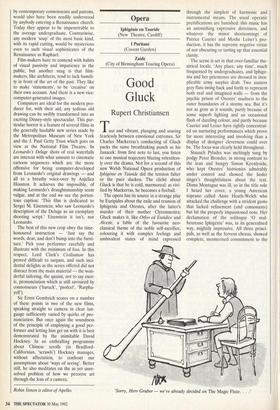by contemporary connoisseurs and patrons, would also have been readily
understood by anybody entering a Renaissance church.
Today they appear to be impenetrable to the average undergraduate. Contrariwise, any modern 'soap' of the most basic kind, with its rapid cutting, would be mysterious even to such visual sophisticates of the Renaissance as Raphael.
Film-makers have to contend with habits of visual passivity and impatience in the public, but another snag is that film- makers, like architects, tend to lack humili- ty in front of the art of the past. They like to make 'statements', to be 'creative' on their own account. And there is a new vice: computer-generated images.
Computers are ideal for the modern pro- ducer for, with their aid, any tedious old drawing can be swiftly transformed into an exciting Disney-style spectacular. This par- ticular horror is a feature of several films in the generally laudable new series made by the Metropolitan Museum of New York and the J. Paul Getty Trust which goes on view at the National Film Theatre. In
Leonardo's Deluge shots of real waterfalls are intercut with what amount to cinematic
cartoon sequences which are the more offensive for being computer-developed from Leonardo's original drawings — and all to a breathy voice-over by Anjelica Houston. It achieves the impossible, of making Leonardo's draughtsmanship seem vulgar, and at the end we see the porten- tous caption: 'This film is dedicated to Sergei M. Eisenstein, who saw Leonardo's description of the Deluge as an exemplary shooting script.' Eisenstein it isn't, nor Leonardo.
The best of this new crop obey the time- honoured instruction — 'Just say the words, dear, and don't bump into the furni- ture.' Pick your performer carefully and illustrate with the minimum of fuss. In this
respect, Lord Clark's Civilisation has
proved difficult to surpass, and such inci- dental delights as the series offered did not distract from the main material — the won- derful tailoring, the quaint, not to say exot- ic, pronunciation which is still savoured by connoisseurs (`baruck', `profeel', `Rarpha- yell').
Sir Ernst Gombrich scores on a number of these points in two of the new films, speaking straight to camera in clear lan- guage sufficiently varied by quirks of pro- nunciation. But once again the soundness of the principle of employing a good per- former and letting him get on with it is best demonstrated by the inimitable David Hockney. In an enthralling programme about Chinese scrolls (in Bradford-
Californian, 'scrawls') Hockney manages, without affectation, to confront our assumptions about 'ways of seeing'. Better still, he also meditates on the as yet unre- solved problem of how we perceive art through the lens of a camera.
















































 Previous page
Previous page